Anatomy of lower airway - Study guides, Class notes & Summaries
Looking for the best study guides, study notes and summaries about Anatomy of lower airway? On this page you'll find 1115 study documents about Anatomy of lower airway.
Page 2 out of 1.115 results
Sort by
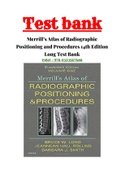
-
Merrill’s Atlas of Radiographic Positioning and Procedures 14th Edition Long Test Bank |3 Volume | Chapter 1 - 30| Complete Guide A+
- Exam (elaborations) • 403 pages • 2022
-
- $22.59
- 2x sold
- + learn more
Merrill’s Atlas of Radiographic Positioning and Procedures 14th Edition Long Test Bank Table of Contents : Volume 1 Preliminary Steps in Radiography 2. General Anatomy and Radiographic Positioning Terminology 3. Thoracic Viscera: Chest and Upper Airway 4. Abdomen 5. Upper Extremity 6. Shoulder Girdle 7. Lower Extremity 8. Pelvis and Hip 9. Vertebral Column 10. Bony Thorax Volume 2 11. Cranium 12. Trauma Radiography 13. Contrast Arthrography 14. Myelography and other Central N...
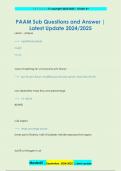
-
PAAM Sub Questions and Answer | Latest Update 2024/2025
- Exam (elaborations) • 39 pages • 2024
- Available in package deal
-
- $12.49
- + learn more
Lesion... plaque ~~> superficial papule rough >1cm ways of opening an unconscious pt's airway ~~> jaw lift, jaw thrust, modified jaw thrust(c-spine), head tilt/chin lift non rebreather mask flow and percentage ~~> 12-15LPM 80-90% LLQ organs ~~> small and large bowel lower part of kidney, half of bladder, female reproductive organs torr/% of nitrogen in air 2 | P a g e | © copyright 2024/2025 | Grade A+ Master01 | September, 2024/2025 | Latest update ~~> 597 ...
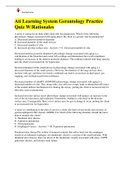
-
SOLVED - ATI Learning System Gerontology Practice Quiz W.Rationales 5Star Rated
- Exam (elaborations) • 18 pages • 2023
-
- $16.99
- 1x sold
- + learn more
A nurse is caring for an older adult client who has pneumonia. Which of the following physiologic changes associated with aging places the client at a greater risk for pneumonia? A. Decreased anterior-posterior diameter B. Increased diameter of the small airways C. Decreased number of cilia D. Increased alveolar surface area - Answers >>C. Decreased number of cilia Decreased anterior-posterior diameterA physiologic change associated with aging is a calcification of the bronchial and costal...
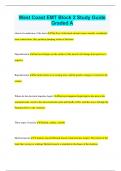
-
West Coast EMT Block 2 Study Guide Graded A
- Exam (elaborations) • 26 pages • 2023
- Available in package deal
-
- $13.09
- 1x sold
- + learn more
electrical conduction of the heart The flow of electrical current causes smooth, coordinated heart contractions; they produce pumping action of the heart Depolarization electrical charges on the surface of the muscle cell change from positive to negative Repolarization the heart returns to its resting state, and the positive charge is restored to the surface Where do the electrical impulses begin? Electrical impulses begin high in the atria in the sinoatrial node, travel to the atrioventr...
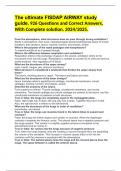
-
The ultimate FISDAP AIRWAY study guide, 926 Questions and Correct Answers, With Complete solution. 2024/2025.
- Exam (elaborations) • 88 pages • 2024
- Available in package deal
-
- $16.49
- + learn more
The ultimate FISDAP AIRWAY study guide, 926 Questions and Correct Answers, With Complete solution. 2024/2025. From the atmosphere, what structures does air pass through during ventilation? Starts in atmosphere, then nose, nasopharyngeal space/orophargyneal space (if mouth breather), then pharynx, larynx, trachea, bronchi, bronchioles, alveoli What is the purpose of the nasal passages and nasopharynx? To warm/humidify air as it passes through What is the difference between respiration and ...

-
FISDAP Airway Exam questions and answers graded A+
- Exam (elaborations) • 21 pages • 2024
- Available in package deal
-
- $17.99
- + learn more
FISDAP Airway ExamFrom the atmosphere, what structures does air pass through during ventilation? - correct answer Starts in atmosphere, then nose, nasopharyngeal space/oropharyngeal space (if mouth breather), then pharynx, larynx, trachea, bronchi, bronchioles, alveoli What is the purpose of the nasal passages and nasopharynx? - correct answer To warm/humidify air as it passes through What is the difference between respiration and ventilation? - correct answer Respiration refers to the exc...
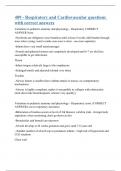
-
409 - Respiratory and Cardiovascular questions with correct answers
- Exam (elaborations) • 27 pages • 2023
- Available in package deal
-
- $14.99
- + learn more
Variations in pediatric anatomy and physiology - Respiratory CORRECT ANSWER Nose -Newborns are obligatory nose breathers until at least 4 weeks old (breathe through nose when cyring; want to make sure nose is clear - use nose aspirator) -Infants have very small nasal passages -Frontal and sphenoid sinuses not completely developed until 6-7 yrs old (less susceptible to get infections) Throat -Infant tongue relatively large to the oropharynx -Enlarged tonsils and adenoids (shrink over time) ...
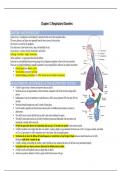
-
Chapter 11 Respiratory Disorders ANATOMY AND PHYSIOLOGY
- Exam (elaborations) • 60 pages • 2024
-
- $7.99
- + learn more
Chapter 11 Respiratory Disorders ANATOMY AND PHYSIOLOGY Upper airway = nasopharynx and oropharynx connected to the ears by the eustachian tubes. The nose, pharynx, and larynx are separated from the lower airway by the trachea. The larynx is covered by the epiglottis. Cilia and mucus in the nostrils warm, clean, and humidify the air. Lower airway = trachea, bronchi, bronchioles, and alveoli. Left lung = two lobes/ Right = three lobes. At the capillaries = oxygen and carbon dioxide diffuse...
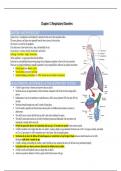
-
Chapter 11 Respiratory Disorders
- Exam (elaborations) • 60 pages • 2024
-
Available in package deal
-
- $7.99
- + learn more
Chapter 11 Respiratory Disorders ANATOMY AND PHYSIOLOGY Upper airway = nasopharynx and oropharynx connected to the ears by the eustachian tubes. The nose, pharynx, and larynx are separated from the lower airway by the trachea. The larynx is covered by the epiglottis. Cilia and mucus in the nostrils warm, clean, and humidify the air. Lower airway = trachea, bronchi, bronchioles, and alveoli. Left lung = two lobes/ Right = three lobes. At the capillaries = oxygen and carbon dioxide diffuse...
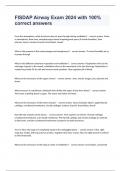
-
FISDAP Airway Exam 2024 Question and answers already passed
- Exam (elaborations) • 21 pages • 2024
-
- $14.49
- + learn more
FISDAP Airway Exam 2024 Question and answers already passed From the atmosphere, what structures does air pass through during ventilation? - correct answer Starts in atmosphere, then nose, nasopharyngeal space/orophargyneal space (if mouth breather), then pharynx, larynx, trachea, bronchi, bronchioles, alveoli What is the purpose of the nasal passages and nasopharynx? - correct answer To warm/humidify air as it passes through What is the difference between respiration and ventilation?...

Did you know that on average a seller on Stuvia earns $82 per month selling study resources? Hmm, hint, hint. Discover all about earning on Stuvia


